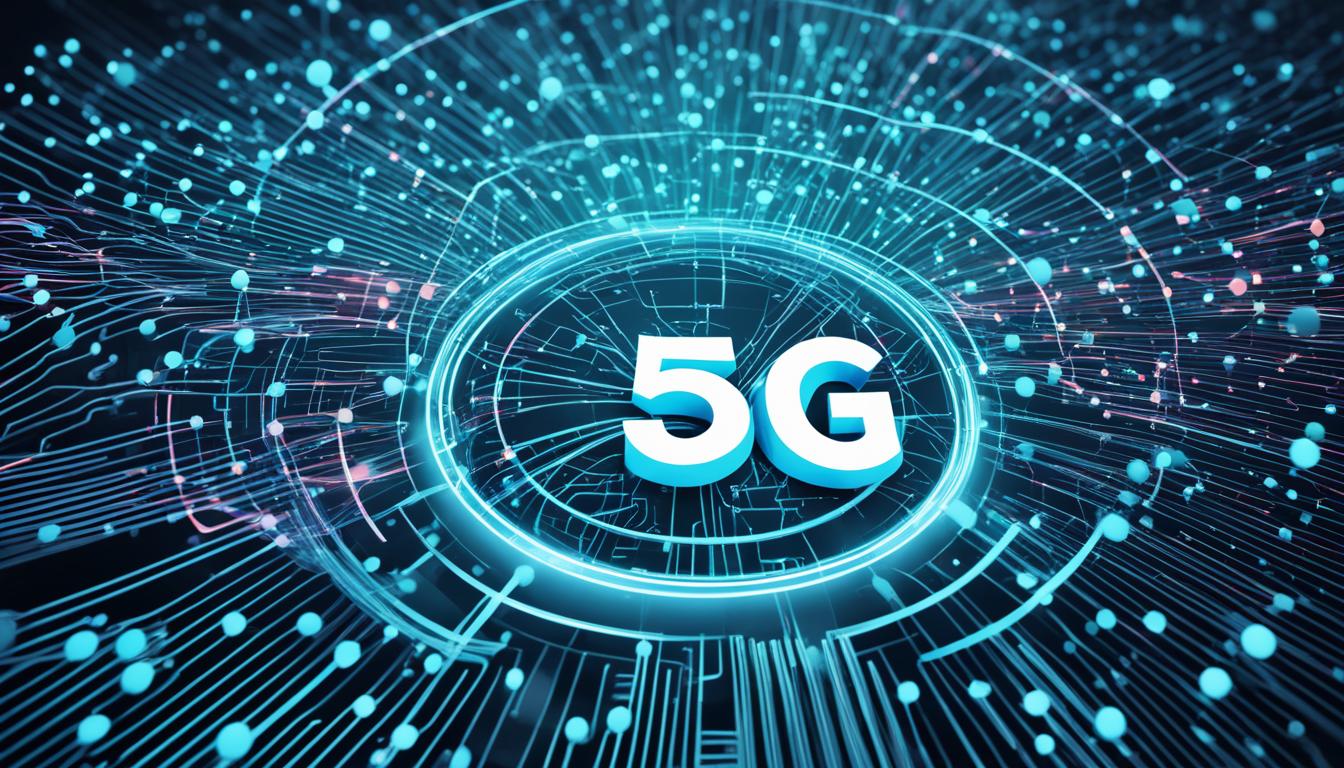The COVID-19 pandemic has dramatically changed our work environment, reshaping how we view remote work. Prior to 2020, only 3.6% of U.S. employees worked from home for half of their hours. By late 2021, this number had surged to over 25%, signaling a shift towards a more enduring remote work culture. As companies discovered that productivity could thrive outside traditional offices, the need for strong connectivity solutions skyrocketed.
The emergence of mid-band 5G technology has been crucial in this shift, enabling millions to access high-speed mobile broadband. This technology is especially beneficial for those embracing 5G Remote Work, ensuring smooth internet connectivity across sectors like healthcare and journalism. It has opened up the concept of “work-from-anywhere,” boosting productivity and job satisfaction through reliable internet access.
Key Insights
- 5G technology significantly boosts internet speeds, enhancing remote work connectivity.
- The pandemic hastened the shift to remote work, with 25% of employees working from home.
- Mid-band 5G enhances video conferencing and collaboration tools.
- Organizations can now access global talent markets, broadening their workforce options.
- AlignMark leads in developing HR solutions that utilize 5G for effective communication.
- 5G technology is poised to redefine work behaviors and establish a new work model.
Understanding 5G Technology
5G technology marks a major shift in mobile networks, transforming how we interact and communicate. It offers ultra-fast data speeds, combining speed, low latency, and vast capacity. This next-generation mobile connectivity ensures seamless connections for multiple devices, enhancing experiences where real-time data transfer is crucial.
The latency has been slashed to just 1 millisecond, a stark improvement over 4G’s 200 milliseconds. This rapid response time is vital for applications needing instant communication, from remote work tools to IoT devices. The ability to support numerous connections at once boosts mobile network efficiency, enabling companies to adopt advanced technologies that meet their operational demands.
5G facilitates real-time data sharing, enabling teams to make quick decisions. This connectivity supports the integration of the Internet of Things (IoT), boosting autonomy and efficiency in managing workflows. As 5G technology advances, its network slicing feature allows companies to tailor their mobile networks for optimal performance and flexibility.

The Evolution of Telecommunications
The telecommunications journey has seen incredible advancements, reshaping our connectivity. It started with the telegraph in the early 19th century, using electrical signals to send messages. This innovation cut down the time it took to send messages, setting the stage for faster communication.
Alexander Graham Bell’s invention of the telephone in 1876 was a major breakthrough. It enabled real-time voice communication over vast distances, connecting people in ways previously unimaginable. This technology not only improved personal relationships but also streamlined business dealings, driving significant social and economic shifts.
Guglielmo Marconi’s work in the late 19th century further advanced telecommunications. His development of wireless telegraphy and transatlantic radio communication set the stage for radio broadcasting. This innovation transformed how information was shared globally.
In the 20th century, mobile connectivity began to take off. The introduction of 1G and 2G networks brought basic voice services. The subsequent advancements in 3G and 4G technologies in the early 2000s significantly boosted data transfer speeds. This led to the proliferation of smartphones and mobile applications, making communication more accessible and dynamic.
The advent of 5G technology around 2010 marked a significant milestone. It offered faster data speeds, lower latency, and support for cutting-edge applications like augmented reality (AR) and virtual reality (VR). 5G’s impact goes beyond just connectivity; it’s redefining remote work and enabling new forms of collaboration and interaction.
Benefits of 5G for Remote Workers
The advent of 5G technology is revolutionizing the work-from-home experience for remote workers. This technology brings numerous enhancements, ensuring your remote work is both effective and enjoyable.
Improved Speed and Connectivity
One of the standout 5G connectivity benefits is its remarkable speed boost. With potential mobile internet speeds over 10 gigabits per second, remote workers can enjoy quicker downloads and seamless video conferencing. The ability to support multiple devices effortlessly is a reality with 5G networks. This leads to high-definition streaming and instant data access, crucial for various remote work tasks.
Reduced Latency and Enhanced Efficiency
Reduced latency, as low as 1 millisecond, is another key advantage. This significantly boosts efficiency. You’ll experience fewer delays when transferring files, joining video meetings, or using collaborative tools. The synergy of improved speed and reduced latency ensures workflows are smoother and uninterrupted, thereby increasing productivity.
The Rise of 5G Remote Work
The shift towards remote work has significantly altered business operations and employee roles. Over the past decade, the U.S. saw a remarkable 159% increase in remote workers. This surge accelerated post-pandemic, aligning with the advent of 5G technology.
5G remote work is transforming traditional employment by offering unparalleled flexibility and accessibility. With more companies embracing permanent remote work policies, employees now enjoy the freedom to work from anywhere. This shift benefits rural workers and those in underserved areas, opening new opportunities for them.

5G technology has brought unlimited bandwidth to remote workers, significantly boosting their productivity and capabilities. The fusion of 5G with extended reality (XR) is set to introduce groundbreaking experiences. These include creating digital twins of physical spaces and objects. Businesses foresee this evolution leading to unprecedented levels of communication and collaboration.
However, the rise of remote work also presents challenges. Companies must evolve their performance metrics to focus on productivity over just hours worked. The flexibility of remote work also increases the risk of burnout. Employees may feel pressured to be constantly available, requiring a shift in workplace culture.
As we move forward in this new era of 5G remote work, it’s crucial to weigh both the benefits and challenges. The future of work is set to be flexible and dynamic, redefining our understanding of employment and collaboration.
5G Connectivity Benefits for Telecommuting
The advent of 5G technology is revolutionizing telecommuting, offering unparalleled benefits to remote workers. Fast and reliable internet access is essential for creating productive work environments. With 5G, you can expect enhanced functionality and efficiency in your daily tasks.
Access to Virtual Collaboration Tools
5G significantly enhances your ability to use various virtual collaboration tools. Real-time applications, such as video conferencing software and project management platforms, experience dramatic improvements in performance. This technology allows you to connect effortlessly with colleagues, regardless of your location.
This new level of connectivity empowers teams to work collaboratively, fostering creativity and streamlining workflows. It’s a game-changer for remote teams.
Network Reliability and Ubiquity
With 5G, network reliability becomes a cornerstone of your telecommuting experience. Consistent internet access eliminates frustrating disruptions during critical tasks, such as meetings or presentations. You can count on lower latency and higher data speeds for seamless interactions with your team members.
The widespread availability of 5G ensures that employees in rural areas enjoy the same robust connectivity as those in urban centers. This promotes equitable access to work opportunities, breaking down geographical barriers.
Remote Work Trends Post-COVID-19
The pandemic has dramatically altered the work landscape, ushering in significant remote work trends. An astonishing 97 percent of employees now crave some form of remote work, with 58 percent leaning towards full-time remote work. Companies are adapting, introducing flexible policies to keep employees happy and on board.
Moreover, nearly 80 percent of workers would be more loyal to employers who offer flexible work arrangements. This highlights the importance of work-life balance in the post-COVID era. Companies are reevaluating their employment strategies to draw in the best talent.
Remote workers are achieving remarkable productivity, often 35-40% higher than those in traditional offices. The office environment, however, is fraught with distractions, costing employers a staggering $600 billion annually. By adopting remote work, companies can avoid these distractions and enjoy a more productive workforce.
The shift towards remote work is also influencing where people choose to live. Many are moving away from cities to places like Meridian, Idaho, where living costs are lower. This shift broadens the talent pool for companies, allowing them to hire skilled professionals from a wider area.
In the post-COVID-19 era, remote work is set to continue, albeit at a lower intensity than during the pandemic’s height. This evolution reflects a new understanding of work, prioritizing employee well-being and job effectiveness. With 14 to 23 million Americans planning to move, the impact on urban planning, infrastructure, and labor markets will be significant.
Impact of 5G on Remote Work Productivity
The advent of 5G technology has significantly impacted remote work, offering numerous benefits for both employees and employers. By 2023, 27% of US employees have transitioned to remote work, a figure expected to rise to 36.2 million remote workers by 2025. This surge underscores the critical need for advanced technologies like 5G to support the growing remote workforce.
5G technology has revolutionized remote work by providing high-speed connectivity and minimal latency. Employees leveraging 5G experience enhanced productivity in tasks that demand swift data transfer, such as video conferencing and cloud-based applications. This improvement is reflected in the views of 40% of US remote employees, who believe they are more productive at home than in traditional offices. Similarly, 90% of remote Canadian employees share this sentiment about their home work environments.
Furthermore, 5G’s advanced infrastructure enables the adoption of automations and integrations that streamline workflows. These advancements allow for the efficient completion of tasks that previously consumed considerable time, enabling individuals to concentrate on their primary duties without interruptions. As remote work expands globally, the pivotal role of 5G in boosting remote work productivity becomes increasingly evident.
However, it is crucial to address concerns regarding work-life balance and connectivity among remote workers. Despite the productivity gains, 68% of employees working from home report increased burnout. Therefore, the flexibility offered by 5G must be balanced with strategies to mitigate the isolation that can accompany remote work.
5G-Enabled Remote Work Solutions
The advent of 5G technology has transformed the way businesses operate remotely. It has brought about a significant shift through the integration of cutting-edge technologies. These advancements have boosted productivity and collaboration among teams. Companies now employ augmented reality (AR) and virtual reality (VR) to create immersive training experiences.
Integration of Emerging Technologies
5G technology’s high-speed mobile internet, exceeding 10 gigabits per second, enables the deployment of sophisticated Internet of Things (IoT) solutions. This surge in bandwidth facilitates real-time data analytics, transforming remote servicing and employee training. Companies like Verizon and Walmart are pioneering the use of VR for innovative training, showcasing the power of these technologies.
- 5G seamlessly connects devices, anticipating a future with approximately 20 billion connected devices.
- The merger of AI and 5G fosters connected intelligence, empowering crucial enterprise decisions.
- Enhancements in customer experiences through virtual collaboration tools become feasible, promoting engagement.
As more devices become compatible with 5G, the potential applications in 5G-enabled remote work solutions expand. This opens up avenues for further innovations in productivity and user experience.
Challenges and Considerations of 5G Deployment
The shift to 5G brings forth substantial hurdles that entities must tackle. The financial strain of building the infrastructure is a major concern. For example, establishing a microcell can reach costs of about $200,000, while smaller cells are closer to $10,000 each. With the aim of installing 60 small cells per square mile for comprehensive coverage, these expenses escalate swiftly. However, network sharing among carriers can ease these financial burdens, potentially cutting the costs of deploying small cells by up to 50%.
Security issues are paramount in the deployment process. Threats aimed at the 5G security framework can disrupt network segments and trigger denial-of-service attacks. It is imperative to continually enhance the 5G security standards to counter these threats. As telecom providers initiate their deployments, they adopt diverse solutions, contingent upon the allocated 5G spectrum and access types.
Technical challenges are inherent in the deployment process, including:
- Spectrum challenges affecting both sub-6GHz and mmWave deployments.
- High site density necessities for mmWave, which complicate coverage issues.
- Device challenges such as limited availability and design constraints.
- Complex synchronization requirements during Hybrid LTE-NR deployments.
When contemplating the deployment considerations for your entity, recognize that these obstacles can impede the swiftness and efficiency of your 5G transition. Crafting a detailed strategy that addresses the challenges of 5G will empower your organization for success in the swiftly evolving telecommunications domain.

Future Implications of Remote Work with 5G
The advent of 5G technology marks a pivotal shift in the future of remote work. Its high speed and bandwidth will revolutionize how we interact with colleagues and partners, improving communication and collaboration. As the job landscape evolves, many roles are set to transition towards fully remote or hybrid models. This shift underscores the need for professionals adept in technology and proficient in using advanced digital tools.
Changing Job Landscapes and Opportunities
Employers now see flexibility as key to attracting and keeping top talent. The growing use of virtual collaboration tools empowers employees to excel in flexible settings. Moreover, 5G’s ability to support high-definition video conferencing with unparalleled quality will redefine remote interactions, allowing seamless connections across distances.
5G will transform talent acquisition strategies. Companies will expand their search to global talent pools, erasing geographical barriers. This shift will prompt the adoption of technologies like augmented reality (AR) and virtual reality (VR) for training and onboarding, offering immersive learning experiences.
The advent of 5G unlocks new opportunities, such as real-time project monitoring via smooth video streams, which can greatly enhance workflows. This will lead to an increase in job openings that value skills in remote operating systems and data analytics. Hence, continuous education and upskilling will be paramount for professional advancement.

As remote work policies evolve, setting clear guidelines on data security and employee duties will be crucial. The work environment is undergoing rapid changes, and adapting to these challenges is vital to leveraging the benefits of remote work’s future.
To delve deeper into 5G’s potential, exploring this detailed article can provide insights into how 5G will reshape work dynamics.
The Remote Work Landscape and Employee Satisfaction
The remote work landscape has seen profound changes over recent years. Technological advancements have led to a clear link between remote work and employee satisfaction. Statistics reveal that nearly 98% of employees prefer working remotely at least part-time, resulting in higher job satisfaction and productivity. This preference for flexibility marks a key trend in today’s workforce.
Organizations that adopt remote work see enhanced employee satisfaction, increased loyalty, and boosted productivity. The shift towards hybrid workplaces has been notable, with a rise from 5.7% to 17.9% in the U.S. between 2019 and 2021. Additionally, 14% now work fully remotely. By 2025, it’s predicted that 22% of the U.S. workforce will work remotely full-time, highlighting a growing focus on flexible work setups.
Remote workers also tend to earn about $4,000 more each year than those in traditional offices. Companies save around $11,000 per remote employee annually when they work partly from home. These financial advantages underscore a critical shift in how companies view employee satisfaction and productivity in the evolving remote work landscape.
Employers aiming for high employee satisfaction must understand that offering remote work options promotes a better work-life balance. As you contemplate these trends, remember that investing in strong technological infrastructures and flexible policies will help your organization succeed in this new work era.
Conclusion
The advent of 5G technology in the realm of remote work heralds a new era of efficiency and connectivity. With its capabilities, expect speeds that are a staggering 100 times faster than the previous standard, 4G. This means instant file transfers and high-definition video conferencing without the usual hitches.
5G’s minimal latency ensures real-time collaboration, cutting down on communication delays. This facilitates seamless interactions across various digital platforms. Additionally, its support for augmented reality (AR) and virtual reality (VR) technologies elevates the work experience. It brings a level of presence akin to face-to-face interactions, previously unattainable in remote settings.
As we move forward, embracing 5G will be crucial for fully leveraging the remote workforce’s potential. By doing so, you’ll contribute to a more dynamic and engaging work environment. This, in turn, will enhance productivity and job satisfaction in our rapidly evolving digital landscape.
FAQ
What is 5G and how does it impact remote work?
How does 5G improve remote work productivity?
What are some of the key benefits of 5G for remote workers?
How does 5G enable access to virtual collaboration tools?
What challenges are associated with the deployment of 5G?
How are remote work trends evolving with the introduction of 5G?
What future opportunities does 5G present for remote work?
How can organizations ensure they leverage the benefits of 5G for remote work?
Source Links
- The Impact of 5G Technology on Remote Work and HR Practices – https://www.alignmark.com/the-impact-of-5g-technology-on-remote-work-and-hr-practices/
- Impact of 5G on workplace – https://www.adeccogroup.com/future-of-work/latest-insights/the-impact-of-5g-on-the-workplace
- The Impact of 5G on Work-from-anywhere Tech | Torii – https://www.toriihq.com/blog/the-impact-of-5g-on-work-from-anywhere-tech
- Impact of 5G Technology on Remote Work [Updated Statistics] – https://zoetalentsolutions.com/impact-of-technology-on-remote-work/
- The Role of 5G in Enhancing Connectivity in Remote Operations – SEE Forge creators of FAT FINGER – https://fatfinger.io/the-role-of-5g-in-enhancing-connectivity-in-remote-operations/
- Council Post: How Hybrid Work Can Benefit From 5G – https://www.forbes.com/sites/forbesbusinesscouncil/2021/06/22/how-hybrid-work-can-benefit-from-5g/
- From Smoke Signals to 5G: A Journey Through the Evolution of Telecommunications Engineering – https://ieeesystemscouncil.org/post/blog/smoke-signals-5g-journey-through-evolution-telecommunications-engineering
- The Third Wave: How 5G Will Drive Job Growth Over the Next Fifteen Years – Progressive Policy Institute – https://www.progressivepolicy.org/publication/the-third-wave-how-5g-will-drive-job-growth-over-the-next-fifteen-years/
- The Importance of 5G Technology for Remote Offices – https://www.office1.com/blog/the-importance-of-5g-technology-for-remote-office
- 5G enables the future of work from anywhere – T-Mobile Newsroom – https://www.t-mobile.com/news/business/5g-enables-the-future-of-work-from-anywhere
- What 5G means for remote workers – https://newsroom.cisco.com/c/r/newsroom/en/us/a/y2020/m03/what-5g-means-for-remote-workers.html
- How 5G Will Transform the Remote Work Experience – VIAVI Perspectives – https://blog.viavisolutions.com/2020/06/24/how-5g-will-transform-the-remote-work-experience/
- The Decentralized Office: Unleashing the Hybrid Work Revolution with 5G – https://www.constellationr.com/blog-news/decentralized-office-unleashing-hybrid-work-revolution-5g
- How 5G Technology Helps with Remote Working – https://www.linkedin.com/pulse/how-5g-technology-helps-remote-working-stephen-miller
- 5G and the Future of Work: Revolutionizing Telecommuting – https://www.linkedin.com/pulse/5g-future-work-revolutionizing-telecommuting-adewf?trk=articles_directory
- Untethering the remote workforce with 5G – https://www.verizon.com/about/news/future-of-5g-and-remote-work
- Remote work as a new normal? The technology-organization-environment (TOE) context – https://www.ncbi.nlm.nih.gov/pmc/articles/PMC9187876/
- PDF – https://futureplaceleadership.com/wp-content/uploads/2021/06/The-Remote-Lab-FPL-Moving-patterns-1.pdf
- Five major challenges of 5G deployment – https://www.essentracomponents.com/en-us/news/industries/telecoms-data/five-major-challenges-of-5g-deployment
- 5 Critical 5G Network Deployment Challenges | Infovista – https://www.infovista.com/blog/5g-network-deployment-challenges
- 5G and the Future of Remote Project Management – https://www.linkedin.com/pulse/5g-future-remote-project-management-joseph-m-jones-jtmfe
- 5G Connectivity: The new era of workplaces – https://www.twobirds.com/en/trending-topics/in-your-corner/5g-connectivity-the-new-era-of-workplaces
- How 5G Will Revolutionize the Future of Work – VIAVI Perspectives – https://blog.viavisolutions.com/2022/08/17/how-5g-will-revolutionize-the-future-of-work/
- Key Hybrid Workplace Statistics to Consider in 2024 — Jake Jorgovan – https://jake-jorgovan.com/blog/hybrid-workplace-statistics-2024
- The Rise of Remote Work: Adapting to a Changing Business Landscape – https://www.linkedin.com/pulse/rise-remote-work-adapting-changing-business-landscape-deep-nova?trk=article-ssr-frontend-pulse_more-articles_related-content-card
- The Impact of 5G on Remote Work: A Connectivity Revolution. – https://www.linkedin.com/pulse/impact-5g-remote-work-connectivity-revolution-siira-world-em6vf
- Revolutionizing Remote Work: How 5G is Transforming the Future of Collaboration – https://insightssuccess.com/revolutionizing-remote-work-how-5g-is-transforming-the-future-of-collaboration/
- 5G and the Future of Remote Work – https://digitaljounal.medium.com/5g-and-the-future-of-remote-work-45c15bedd04a


